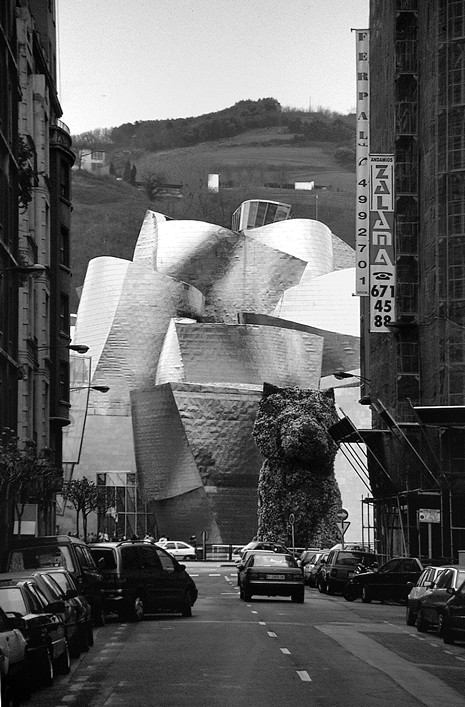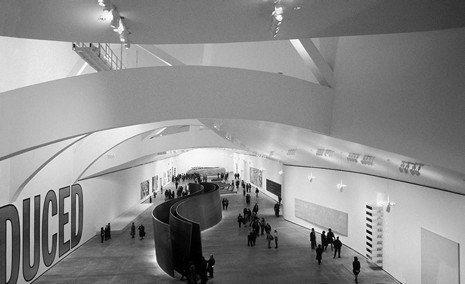Description
This ambitious project pursued the goal of creating on one hand a spectacular new architectural landmark for Bilbao in order to give back to the Basque metropolis the brilliance it had lost through economic decline and social unrest, and on the other, an appropriate framework for the Guggenheim Foundation’s practice of lending and exhibiting worldwide. As an expression of the underlying museum concept both striking and functional at the same time, it also had to measure up to Frank Lloyd Wright’s Guggenheim Museum in New York, countering this incunabulum of museum architecture with a contemporary equivalent.
Between the late nineteenth century buildings of the city centre and the river bank at the foot of a mountain, between a container terminal and a dominant motorway bridge, the architect favoured from the outset for this commission placed a variform structure that is almost indescribable. Its appearance seems to be continually changing and precisely because of that, it is able to focus the heterogeneous topography, apparently as a matter of course, without giving up its aesthetic distance. Like an elastic creature, the shining volume – either silver or gold depending on the weather – nestles into its surroundings in such a way as to evoke intentional associations that range from an enormous animal to the reflection of a ship in the water. At all events, they embody movement, dynamism, and growth. At the same time, Gehry also wants the rampant stackings and inversions of his architecture – which does not seem to obey any recognizable rules – to be understood as a monument to his conviction that “the real order is disorder” and that in view of the social upheavals in our time, any demonstration of a stable order would be self-deception. However, the loss of semantic clarity that accompanies the enormously intensified rhetoric of this language of form also allows one to interpret – hardly less plausibly – the complexity of this building and its illusionist effects as an expression of a Baroque world view, in which the domination of international capital over local culture is manifest and aesthetic sensation is justified by its economic success.
The largely biomorphous form of this sculptural architecture, which Gehry gradually developed out of the cubist dismemberment of geometric bodies – put to the test in an exemplary fashion in the Vitra Design Museum in Weil am Rhein, for example – was only realizable with this consistency and perfection with the aid of a computer program used for aircraft construction (CATIA), which defines every three-dimensional form as an equation and can thereby determine every point on its surface.
With this tool, the form developed in a long design process operating essentially with models could be translated into a supporting structure laid out as a basket-like network of steel sections. While a secondary supporting system for the curved walls and ceilings was covered over with gypsum plasterboard inside, the volume’s exterior – apart from the rectangular parts of the building, executed in Spanish limestone and the glazed curtain walls – was clad with scales of sheet titanium, each of a different size, which the architect selected after protracted experiments because of its special colour and its changing reflective capabilities, but above all, because of its extraordinary mechanical and chemical durability. The extreme thinness of the titanium sheets (measuring only 0.38 millimetres) lends the surfaces a rippling quality that makes the building seem alive.
The pivotal point and fulcrum of the museum is the atrium, more than 50 metres high, placed directly behind the main entrance. It was inspired by the expressionist spatial vision in Fritz Lang’s movie Metropolis (1927). It is flooded with light pouring through the glazed curtain wall and a roof construction formed like a plant, which is Gehry’s interpretation of the classic museum dome. Accessing the radially arranged exhibition rooms distributed over three levels are bridges of steel, suspended catwalks and glass elevators – which offer views of the city and the river, but above all, ever new and surprising perspectives onto this almost incomparable spatial form that blurs the boundaries between inside and outside and overcomes the restraints of gravity. “Fish,” the architect’s name for the 130-metre long tunnel-shaped hall with continually changing contours that is by far the largest of these rooms – and whose ceiling devoid of columns is suspended by a flexible network of struts – extends eastwards up to and underneath the motorway bridge. The majority of the galleries, however, are almost quadratic rooms strung together in enfilade, on two levels, one on top of the other. Those on the third floor are illuminated conventionally with light from above that through an opening in the middle of the floor also reaches the galleries below. Apart from that, the rooms are illuminated by a special system of lighting bridges and wall spotlights that enables evenly distributed lighting at eye-level. Finally, as the third room-type, almond-shaped cave-like or free-form exhibition rooms, each with its own individual character, complete the selection of different possibilities for presenting and observing art.
ARCH+ 128/1995, pp. 24-25 • Werk, Bauen und Wohnen 12/1995, pp. 40-44; 12/1996, pp. 22-25; 12/1997, pp. 56-57 (Jürg Senn) • Architectural Record 10/1997, pp. 74-87 (Karen D. Stein) • The Architectural Review 1210/1997, pp. 30-45 (Catherine Slessor; Annette LeCuyer) • L’architecture d’aujourd’hui 313/1997, pp. 43-73 (Jean-Paul Robert) • Art in America 7/1997, pp. 48-55, 105-106 (Kim Bradley) • Domus 798/1997, pp. 10-19 (Sebastiano Brandolini) • Coosje van Bruggen, Frank O. Gehry. Guggenheim Museum Bilbao, Ostfildern-Ruit, 1997 • Bauwelt 13/1997, pp. 682-693 (Antón Amann Murga/Fernando Pérez Fraile/César Caicoya Gómez-Morán; Javier Mozas) • Deutsche Bauzeitung 12/1997, pp. 22-23 (David Cohn) • Francisco Asensio Cerver, The Architecture of Museums, New York, 1997, pp. 72-83 • Architecture and Urbanism 334/1998, pp. 110-132 (Michael Webb) • Der Architekt 9/1998, pp. 506-508 (upw Nagel) • El Croquis 88-89/1998, pp. 22-63 • Deutsche Bauzeitschrift 1/1998, pp. 49-54 (Benedikt Kraft) • GA document 54/ 1998, pp. 6-93 • Lotus 98/1998, pp. 6-26 (Pierluigi Nicolin) • Kurt W. Forster, Frank O.Gehry. Guggenheim Bilbao Museoa, Stuttgart/London, 1998 • Francesco dal Co/Kurt Forster, Frank O. Gehry. Milan, 1998, pp. 480-487 • Justin Henderson, Museum architecture, Gloucester/Mass., 1998, pp. 32-39 • Victoria Newhouse, Towards a New Museum, Ostfildern-Ruit, 1998, pp. 245-259 • Gerhard Mack, Art Museums. Into the 21st Century Basel/Berlin/Boston, 1999, pp. 23-36 • Luca Basso Peressut, musei. Architetture 1990 -2000, Milan, 1999, pp. 208-221 • Vittorio Magnago Lampugnani/Angeli Sachs (eds.), Museums for a New Millennium, Munich/London/New York, 1999, pp. 124-131 (Kurt W. Forster) • Frank Maier-Solgk, Die neuen Museen, Cologne, 2002, pp. 71-79 • Annett LeCuyer, Stahl & Co., Basel, 2003, pp. 44-49
Drawings
Ground floor
Second floor
Fourth floor
Cross section
Longitudinal section
Model of the steel structure
Photos

The museum, a shining sculpture in front of the dark mountain, forms the ending point of the street leading from the city to the river.

View from the balcony into the gallery on the ground floor resembling a ship’s belly; even Richard Serra’s steel snake, which is 31 metres long and 4 metres high, seems almost lost within it.
Originally published in: Paul von Naredi-Rainer, Museum Buildings: A Design Manual, Birkhäuser, 2004.